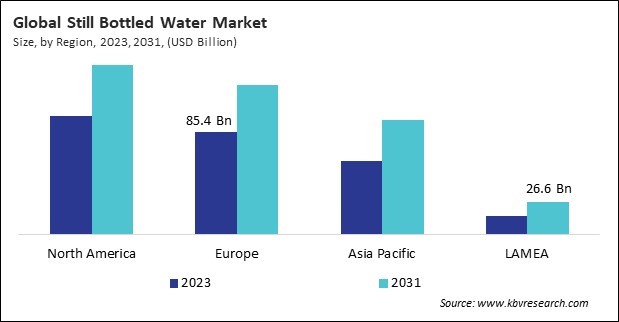The Still Bottled Water Market is Predict to reach USD 388.4 Billion by 2031, at a CAGR of 5.3%
Special Offering :
Industry Insights | Market Trends | Highest number of Tables | 24/7 Analyst Support
Still Bottled Water Market Growth, Trends and Report Highlights
According to a new report, published by KBV research, The Global Still Bottled Water Market size is expected to reach $388.4 billion by 2031, rising at a market growth of 5.3% CAGR during the forecast period. In the year 2023, the market attained a volume of 81,162.12 million units (1 Litre), experiencing a growth of 12.3% (2020-2023).
The Glass segment is anticipating a CAGR of 6.3% during (2024 - 2031). Glass bottles are incredibly durable and can be reused countless times. This significantly reduces plastic waste compared to single-use PET bottles. Environmentally conscious consumers who want to minimize their footprint appreciate this reusability. Many consumers believe glass bottles impart a purer taste to water than PET plastic. Glass is non-porous, meaning it doesn't leach any chemicals or flavors into the water, potentially improving the taste experience.

The Convenience Stores segment is leading the Global Still Bottled Water Market 2020 in 2023; thereby, achieving a market value of $86.7 billion by 2031. Their strategic locations, extended operating hours, focus on single-serve options, and impulse buy potential make them an essential part of the off-trade sector in the still bottled water market. Convenience stores are strategically placed in high-traffic areas, like gas stations, busy intersections, or office buildings. This ensures they're readily accessible to people on the move, whether commuting to work, running errands or simply out and about.
The More than 1.5 Liters segment is registering a CAGR of 4.9% during (2024 - 2031). These larger bottles are ideal for families or groups who need a readily available drinking water supply at home or during outings. They eliminate the need for frequent purchases or refills of smaller bottles. For camping trips, sporting events, or outdoor activities where high water consumption is likely, these larger bottles provide a portable and sufficient water supply for extended periods.
Full Report: https://www.kbvresearch.com/still-bottled-water-market/
The North America region dominated the Global Still Bottled Water Market by Region in 2023, and would continue to be a dominant market till 2031; thereby, achieving a market value of $141.5 billion by 2031. The Europe region is experiencing a CAGR of 5% during (2024 - 2031). Additionally, The Asia Pacific region would showcase CAGR of 5.9% during (2024 - 2031).
List of Key Companies Profiled
- PepsiCo, Inc.
- Nestle S.A.
- Danone S.A.
- The Coca-Cola Company
- Nongfu Spring Co., Ltd.
- Mountain Valley Spring Company, LLC (Primo Water Corporation)
- Gerolsteiner Brunnen GmbH & Co KG
- VOSS of Norway AS (Reignwood Group)
- National Beverage Corporation (IBS Partners, Ltd.)
Still Bottled Water Market Report Segmentation
By Bottle Type (Volume, Million Units (1 Litre), USD Billion, 2020-2031)
- PET
- Glass
By Distribution Channel (Volume, Million Units (1 Litre), USD Billion, 2020-2031)
- Supermarkets & Hypermarkets
- Convenience Stores
- Grocery Stores
- Online
- Others
By Size (Volume, Million Units (1 Litre), USD Billion, 2020-2031)
- 5 Liters to 1.0 Liters
- More than 1.5 Liters
- Up to 0.5 Liters
- 0 Liters to 1.5 Liters
By Geography (Volume, Million Units (1 Litre), USD Billion, 2020-2031)
- North America
- US
- Canada
- Mexico
- Rest of North America
- Europe
- Germany
- UK
- France
- Russia
- Spain
- Italy
- Rest of Europe
- Asia Pacific
- China
- Japan
- India
- South Korea
- Singapore
- Malaysia
- Rest of Asia Pacific
- LAMEA
- Brazil
- Argentina
- UAE
- Saudi Arabia
- South Africa
- Nigeria
- Rest of LAMEA
Related Reports:



